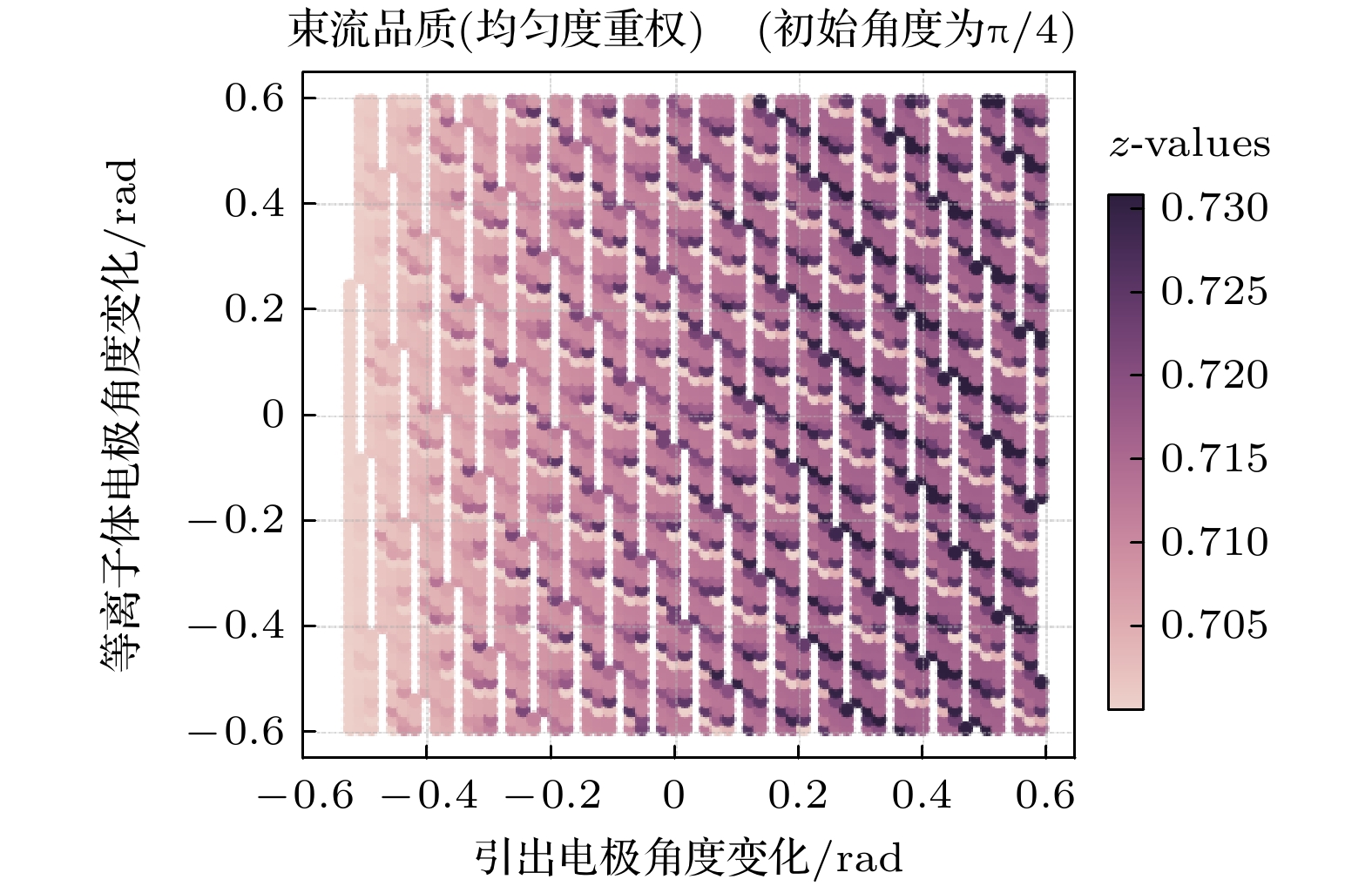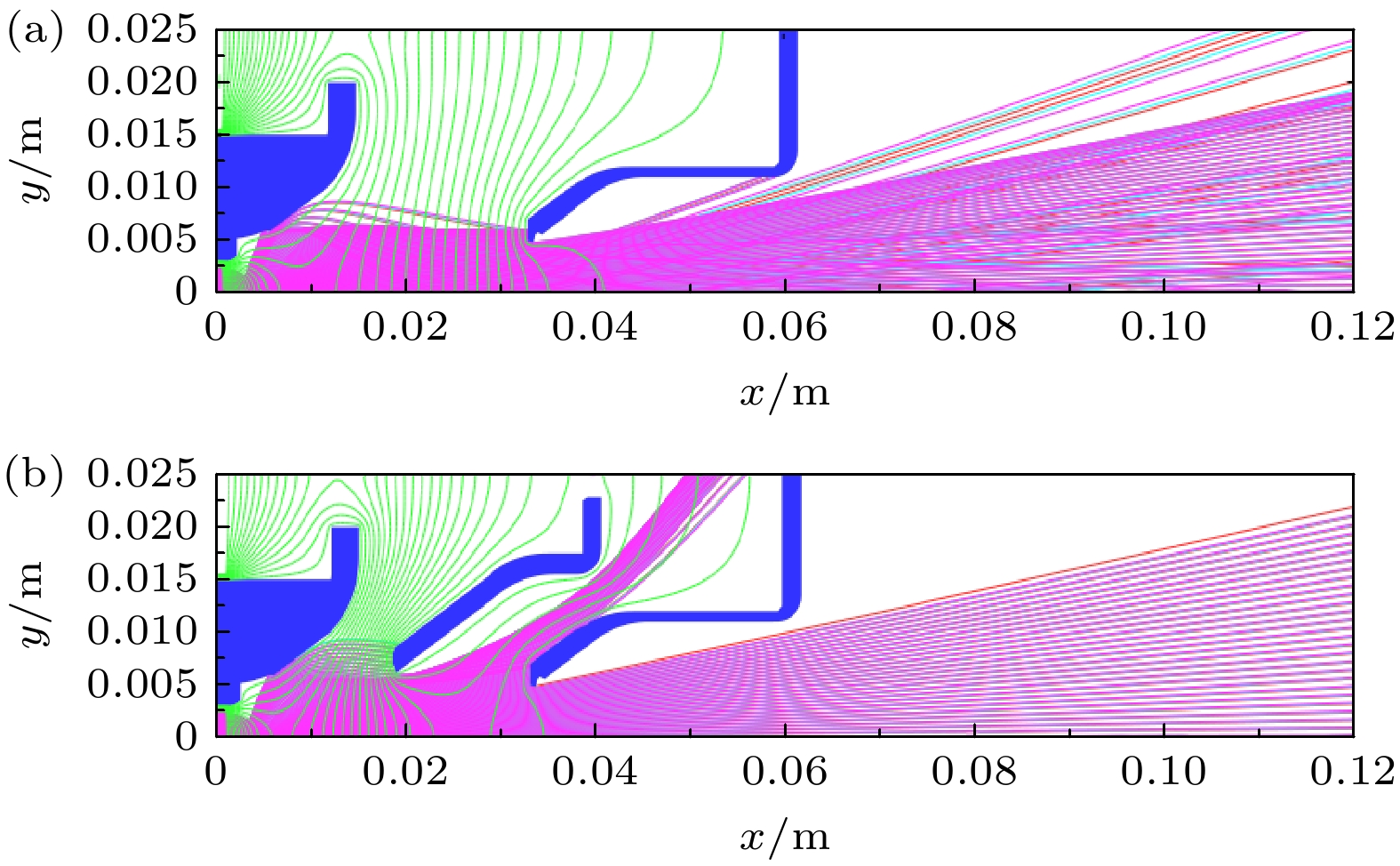-
随着高端光学器件镀膜的发展, 其多样性溅射镀膜需求对离子束流流强、均匀度和可调性提出了更高的要求. 对于新一代离子束溅射镀膜机来说, 如何在不同离子比、不同流强的束流下保持足够的均匀度, 成为了溅射镀膜设备的一大难题. 本文提出了一种基于三电极引出系统的优化模拟方法, 模拟和优化了离子源的引出系统, 研究了等离子体电极、抑制电极、引出电极的形状、角度、距离对离子束引出性能的影响. 同时, 重点研究了离子比对束流引出的影响. 该模型可以指导科研工作者根据离子源的状态和应用需求, 对三电极引出系统的角度、距离和形状进行系统优化并找出最优解. 最后, 本文还给出了一种方法对混合离子束的溅射深度进行了估算.The widespread application of ion beam sputtering coating, especially in optical devices, requires the improvement of beam current intensity and uniformity of large-area uniform coatings. The advent of high current Penning sources offers a potential solution. This study introduces an automated optimization simulation method based on a three-electrode extraction system to investigate its influence on ion beam quality and uniformity. Focusing on high current intensity and uniformity, our simulation explores the effects of plasma electrode, inhibition electrode, and extraction electrode angles and distances on ion beam performance. Evaluation metrics include average beam intensity density, average energy of a single particle, and reciprocal variance of each macro particle position, which are achieved through normalization functions, allowing comprehensive comparison of simulation results. To assess coating efficiency, we estimate sputtering yield and depth. The study identifies patterns among electrodes and emphasizes the influence of different ion ratios on beam extraction. The results indicate that optimizing the angle of the plasma electrode and the distance of the suppressed electrode yields a highly uniform ion beam for low charge ions. However, for highly charged ions, similar optimization will reduce the current strength, so compensation needs to be achieved through electrode shape optimization. This research provides a model for systematically optimizing the three-electrode extraction system, guiding researchers in achieving optimal solutions based on ion source characteristics and application requirements. Additionally, we introduce a method of estimating the sputtering depth of mixed ion beams. This study provides valuable insights for advancing ion beam sputtering coating technology and reference for making the decision on design and application of ion source.
-
Keywords:
- sputter deposition coating /
- extraction system /
- automatic optimization /
- beam extraction simulation
[1] Wei D T 1989 Appl. Opt. 28 2813
 Google Scholar
Google Scholar
[2] Ristau D 2005 Proc. SPE 5963 596313
 Google Scholar
Google Scholar
[3] Becker J, Scheuer V 1990 Appl. Opt. 29 4303
 Google Scholar
Google Scholar
[4] 刘金声2003离子束沉积薄膜技术及其应用(北京: 国防工业出版社)第50—58页
Liu J S 2003 Ion Beam Deposition Film Technology and Application (Beijing: National Defense Industry Press) pp50–58
[5] Kumar T S, Prabu S B, Manivasagam G 2014 J. Mater. Eng. Perform. 23 2877
 Google Scholar
Google Scholar
[6] Nouri Z, Li R, Holt R A 2010 Nuclear Instr. Meth. A 614 174
 Google Scholar
Google Scholar
[7] Mamedov N V, Maslennikov S P, Presnyakov Y K, Solodovnikov A A, Yurkov D I 2019 Tech. Phys. 64 1290
 Google Scholar
Google Scholar
[8] Zhang A L, Li D, Xu L C, Xiong Z J, Zhang J Y, Peng H P, Luo Q 2022 Phys. Rev. Accel. Beams 25 103501
 Google Scholar
Google Scholar
[9] 方应翠 2014 真空镀膜原理与技术 (北京: 高等教育出版社) 第183—190页
Fang Y C 2014 Principle and Technology of Vacuum Coating (Beijing: Higher Education Press) pp183–190
[10] 王惠三, 简广德, 周才品, 雷光玖, 姜韶风, 卢大伦, 江涛 2001 核聚变与等离子体物理 21 101
Wang H S, Jian G D, Zhou C P, Lei G J, Jiang S F, Lu D L, Jiang T 2001 Nuclear Fusion and Plasma Physics 21 101
[11] 陈佳洱 1993 加速器物理基础(初版) (北京: 原子能出版社) 第29—30页
Chen J E 1993 Fundamentals of Accelerator Physics (First Edition) (Beijing: Atomic Energy Press) pp29–30
[12] Macdonald J A 2020 Ph. D Dissertation (Columbia: The University of Columbiabritish
[13] Zhang M, Vassiliadis S, Delgado-Frias J G 1996 IEEE Trans. Comput. 45 1045
 Google Scholar
Google Scholar
[14] Bohdansky J 1984 Nuclear Instrum. Methods Phys. Res. B 2 587
 Google Scholar
Google Scholar
[15] Seah M P, Clifford C A, Green F M, Gilmore I S 2005 Nuclear Instrum. Methods Phys. Res. B 37 444
 Google Scholar
Google Scholar
[16] 王云, 陈志, 赵红卫, 赵阳阳, 孙良亭, 杨尧, 钱程, 武启, 马鸿义, 张文慧, 张子民, 张雪珍, 刘占稳 2013 原子核物理评论 30 141
 Google Scholar
Google Scholar
Wang Y, Chen Z, Zhao H W, Zhao Y Y, Sun L T, Yang Y, Qian C, Wu Q, MA H Y, Zhang W H, Zhang Z M, Zhang X Z, Liu Z W 2013 Nucl. Phys. Rev. 30 141
 Google Scholar
Google Scholar
[17] IBSimu Reference Manual, Doxygen https://ibsimu.sourceforge.net/manual.html [2023-9-13
[18] Ren H T, Zhao J, Peng S X, Lu P N, Zhou Q F, Xu Y, Chen J, Zhang T, Zhang A L, Guo Z Y, Chen J E 2014 Rev. Sci. Instrum. 85 2
 Google Scholar
Google Scholar
[19] Yamamura Y, Tawara H 1996 At. Data Nucl. Data Tables 62 149
 Google Scholar
Google Scholar
[20] Wei Q, Li K D, Lian J, Wang L M 2008 J. Phys. D 41 172002
 Google Scholar
Google Scholar
[21] Sigmund P 1973 J. Mater. Sci. 8 1545
 Google Scholar
Google Scholar
-
图 3 各电极角度变化量对束流品质的影响 (a)三电极同步角度调整; (b)等离子体电极角度调整; (c)抑制电极角度调整; (d)引出电极角度调整
Fig. 3. Influence of angle variation of each electrode on beam quality: (a) Three-electrode synchronization angle adjustment; (b) plasma electrode angle adjustment; (c) inhibit electrode angle adjustment; (d) extraction electrode angle adjustment.
表 1 潘宁源参数
Table 1. Parameters of penning source.
参数 符号 单位 值 束流流强密度 J A/m 0.1 等离子体极电位 V1 keV 1.5 引出电极电位 V2 V 0 电离室轴向引出开口 r m 0.003 表 2 优化参数
Table 2. Optimized parameters.
参数 符号 单位 值 束流流强密度 J A/m2 0.1 电极的角度变化 Angle rad 0 抑制电极与离子源的距离 l1 m 0.0185 引出电极与离子源的距离 l2 m 0.033 表 3 优化电极的角度选择
Table 3. Optimize electrode angle selection.
组别 等离子体电极
角度变化/rad引出电极
角度变化/rad加权评估值 1 0 0.331613 0.7300489 2 0.24 0.19 0.7300489 3 –0.0174 0.21 0.73071698 4 0.21 0.227 0.73080603 5 0.19 0.4 0.73085056 表 4 优化抑制电极的选择
Table 4. The selection of optimized inhibition electrode.
组别 等离子体电极
角度变化/rad引出电极
角度变化/rad抑制电极位置/m 1 0 0.331613 0.019 2 0.21 0.227 0.030 3 0.21 0.227 0.022 -
[1] Wei D T 1989 Appl. Opt. 28 2813
 Google Scholar
Google Scholar
[2] Ristau D 2005 Proc. SPE 5963 596313
 Google Scholar
Google Scholar
[3] Becker J, Scheuer V 1990 Appl. Opt. 29 4303
 Google Scholar
Google Scholar
[4] 刘金声2003离子束沉积薄膜技术及其应用(北京: 国防工业出版社)第50—58页
Liu J S 2003 Ion Beam Deposition Film Technology and Application (Beijing: National Defense Industry Press) pp50–58
[5] Kumar T S, Prabu S B, Manivasagam G 2014 J. Mater. Eng. Perform. 23 2877
 Google Scholar
Google Scholar
[6] Nouri Z, Li R, Holt R A 2010 Nuclear Instr. Meth. A 614 174
 Google Scholar
Google Scholar
[7] Mamedov N V, Maslennikov S P, Presnyakov Y K, Solodovnikov A A, Yurkov D I 2019 Tech. Phys. 64 1290
 Google Scholar
Google Scholar
[8] Zhang A L, Li D, Xu L C, Xiong Z J, Zhang J Y, Peng H P, Luo Q 2022 Phys. Rev. Accel. Beams 25 103501
 Google Scholar
Google Scholar
[9] 方应翠 2014 真空镀膜原理与技术 (北京: 高等教育出版社) 第183—190页
Fang Y C 2014 Principle and Technology of Vacuum Coating (Beijing: Higher Education Press) pp183–190
[10] 王惠三, 简广德, 周才品, 雷光玖, 姜韶风, 卢大伦, 江涛 2001 核聚变与等离子体物理 21 101
Wang H S, Jian G D, Zhou C P, Lei G J, Jiang S F, Lu D L, Jiang T 2001 Nuclear Fusion and Plasma Physics 21 101
[11] 陈佳洱 1993 加速器物理基础(初版) (北京: 原子能出版社) 第29—30页
Chen J E 1993 Fundamentals of Accelerator Physics (First Edition) (Beijing: Atomic Energy Press) pp29–30
[12] Macdonald J A 2020 Ph. D Dissertation (Columbia: The University of Columbiabritish
[13] Zhang M, Vassiliadis S, Delgado-Frias J G 1996 IEEE Trans. Comput. 45 1045
 Google Scholar
Google Scholar
[14] Bohdansky J 1984 Nuclear Instrum. Methods Phys. Res. B 2 587
 Google Scholar
Google Scholar
[15] Seah M P, Clifford C A, Green F M, Gilmore I S 2005 Nuclear Instrum. Methods Phys. Res. B 37 444
 Google Scholar
Google Scholar
[16] 王云, 陈志, 赵红卫, 赵阳阳, 孙良亭, 杨尧, 钱程, 武启, 马鸿义, 张文慧, 张子民, 张雪珍, 刘占稳 2013 原子核物理评论 30 141
 Google Scholar
Google Scholar
Wang Y, Chen Z, Zhao H W, Zhao Y Y, Sun L T, Yang Y, Qian C, Wu Q, MA H Y, Zhang W H, Zhang Z M, Zhang X Z, Liu Z W 2013 Nucl. Phys. Rev. 30 141
 Google Scholar
Google Scholar
[17] IBSimu Reference Manual, Doxygen https://ibsimu.sourceforge.net/manual.html [2023-9-13
[18] Ren H T, Zhao J, Peng S X, Lu P N, Zhou Q F, Xu Y, Chen J, Zhang T, Zhang A L, Guo Z Y, Chen J E 2014 Rev. Sci. Instrum. 85 2
 Google Scholar
Google Scholar
[19] Yamamura Y, Tawara H 1996 At. Data Nucl. Data Tables 62 149
 Google Scholar
Google Scholar
[20] Wei Q, Li K D, Lian J, Wang L M 2008 J. Phys. D 41 172002
 Google Scholar
Google Scholar
[21] Sigmund P 1973 J. Mater. Sci. 8 1545
 Google Scholar
Google Scholar
计量
- 文章访问数: 6300
- PDF下载量: 133
- 被引次数: 0














 下载:
下载:











